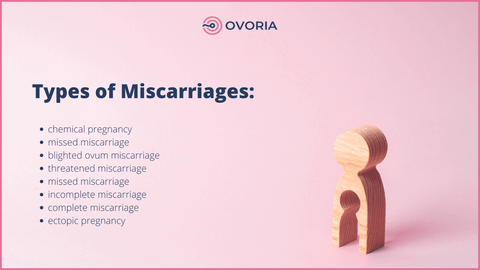Miscarriage: Types, Symptoms and Causes
The American College of Obstetricians and Gynecologists says that miscarriage is the most common type of pregnancy loss, and studies show that 10–25% of all clinically recognized pregnancies will end in miscarriage. A miscarriage is a term used for a pregnancy that ends on its own by the 20th week.

What Is a Miscarriage?
Early pregnancy loss (also called miscarriage) is when a baby dies in the womb (uterus) before 20 weeks. For women who know they're pregnant, about 10 to 15 in 100 pregnancies (10 to 15 per cent) end in miscarriage. Most miscarriages happen in the first trimester, but if you miscarry in the second trimester, it doesn't mean your pregnancy isn't viable. Miscarriage rates are about 1 to 5 per cent.
The APA (American Pregnancy Association) says that miscarriages happen in 10%-25% of all pregnancies.
Types of Miscarriages
There are several types of miscarriages, which means that Not all miscarriages are the same. Some will occur before 12 weeks of pregnancy, while others may occur later during pregnancy.
Chemical Pregnancy: A chemical pregnancy is a miscarriage that occurs shortly (usually it happens before or after the fifth week)after a positive pregnancy test. Nearly 50-70% of miscarriages are due to chemical pregnancies. A chemical pregnancy can be identified by bleeding around the time of a regular period. In the first trimester, the fetus is too small for an ultrasound to detect any chromosomal abnormalities. The most common sign of chemical pregnancy is Low levels of HCG hormone on a blood test.
Threatened Miscarriage: This type of miscarriage can be defined as any vaginal bleeding that happens during the first 20 weeks of pregnancy while the cervix remains closed. Despite the anxiety that it causes, this occurrence is widespread in early pregnancy, especially in the first trimester.
Blighted Ovum Miscarriage: Blighted ovum, also known as anembryonic pregnancy, is when a fertilized egg implants and does not develop into a viable embryo and may stop developing. Once fertilizes the egg, it gets resorbed, leaving an empty gestational sac (large fluid cavity) and the intact placenta. It is often more common for women who have blighted ovum to miscarry during the first trimester.
Missed Miscarriage: A missed miscarriage is also a silent miscarriage because women typically won't experience symptoms like cramping or heavy bleeding.
Inevitable Miscarriage: An inevitable miscarriage is the presence of an open internal os in the fact of bleeding in the first trimester of pregnancy.
Incomplete Miscarriage: A miscarriage is called "incomplete" because bleeding has begun and the cervix is dilated, but tissues from the pregnancy remain in the uterus. In most cases, a miscarriage that's not complete at the time of diagnosis will run its course without further intervention.
Complete Miscarriage: A complete miscarriage (also known as complete abortion) is defined as the loss of an embryo or fetus before it can be felt or seen by a doctor.
Recurrent miscarriage: A recurrent miscarriage is defined as two or more miscarriage losses in a row. It’s estimated that around 1 per cent of American women experience pregnancy loss, although some may be successful with subsequent pregnancies.
Ectopic pregnancy: Women who are at the age of childbearing, if sexually active, are at risk of ectopic pregnancy and mostly the causes are never determined. However, there are certain causes of ectopic pregnancy which trigger ectopic pregnancy more often. The causes of ectopic pregnancy can include fertility treatment, maternal age, endometriosis or uterine abnormalities

Miscarriage Symptoms
Many miscarriages occur before the 12th week of pregnancy. The most common symptoms of miscarriage are spotting and cramping. Spotting turns into heavier bleeding. Cramping starts and becomes stronger. Most women can also experience other symptoms during early miscarriage:
- Vaginal spotting or bleeding
- Back pain
- Light cramping
- Nausea
- Abdominal or back pain
- Feeling sick
If you experience any of these symptoms during the early stage of pregnancy, you need to call your doctor and provide medical advice for having a healthy and successful pregnancy.
What Causes Miscarriage?
It is widespread that women blame themselves when they have a miscarriage; it's so important not to do so. The most common cause of miscarriage is a genetic or chromosomal abnormality in the embryo. Other risk factors causing miscarriage are listed below:
Chromosome problems
When a miscarriage happens in the first 12 weeks, more than half the time, it's because of problems with the baby's chromosomes. Chromosomes are blocks of DNA that contain detailed instructions for cells and characteristics such as eye colour. Sometimes, something goes wrong at the time of conception, and the foetus receives too many or not enough chromosomes. The reason for this process is unclear, but it will lead to miscarriage. Chromosomal abnormalities can also cause Intrauterine fetal demise, Blighted ovum or moral pregnancy.
Medical conditions
A pregnancy loss sometimes results from a problem with the mother's health. There is a list of medical conditions that can impact fertility and a woman can have a higher risk of miscarriage. For example:
- heart disease
- diabetes
- high blood pressure
- thyroid disease
- lupus or immune system disorders
- infections such as chlamydia, gonorrhoea or syphilis
Diagnosis of Miscarriage
If a woman thinks she may be having a miscarriage, she needs to tell the doctor about her symptoms and signs, including when the bleeding started, how heavy it's been, and whether she has had pain or cramping. The doctor can direct the patient to do genetic tests, physical exams and ultrasound for checking the baby's heartbeat. Moreover, a woman can also get blood tests to check the hCG (human chorionic gonadotropin) hormone level.

